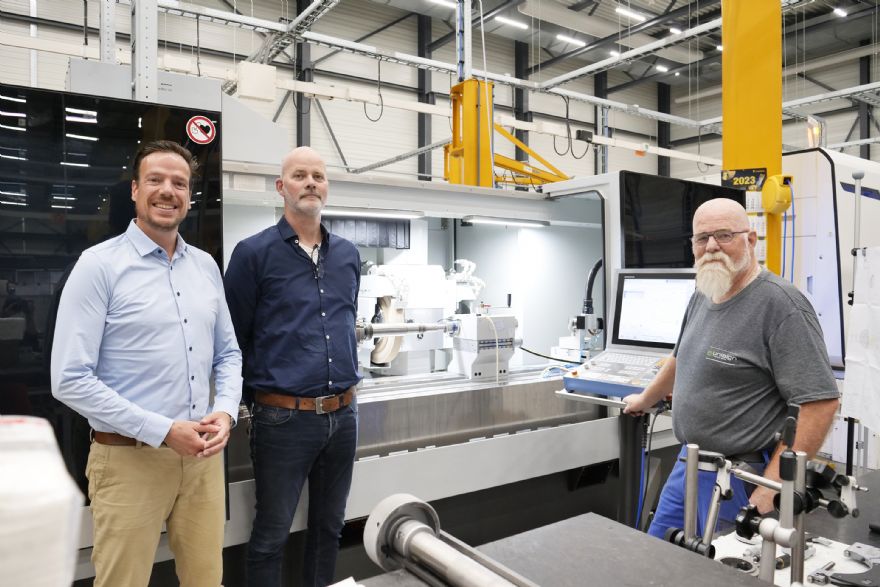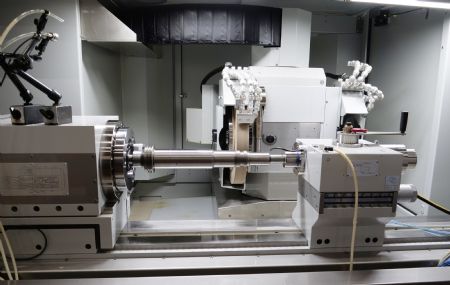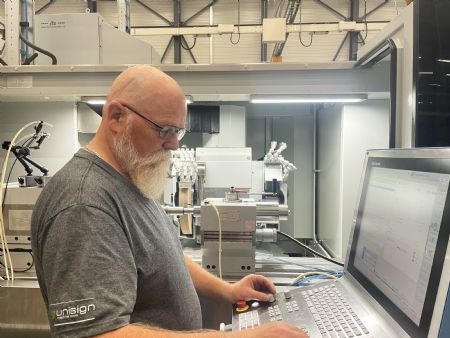 René van der Peet (BMT), Paul Lennaerts and Jan Litjens (both Unisign) in front of the Kellenberger 1000
René van der Peet (BMT), Paul Lennaerts and Jan Litjens (both Unisign) in front of the Kellenberger 1000For 50 years,
Unisign, a Dutch manufacturer of portal milling machines and machining centres, has been developing high-end CNC machining centres for milling, drilling and turning that are customisable and user-friendly. With over 80% of components produced in-house, including all high-precision workpieces, the company ensures that its know-how remains within the company.
When Bart van Ruth established his first design office, the goal was to find technological solutions for productivity improvements. The development of his first product, a vertical, column-moving CNC drilling machine with a fixed machine bed, brought success especially on the German market. In 1988, the company’s first gantry milling machine for five-sided machining of workpieces followed.
Special machinesToday, Unisign portal machines, travelling column machines and multi-tasking machining centres are in demand from customers in a wide range of sectors, including logistics and energy, commercial vehicles and general engineering — a large number of them purchased as special machines. The range of parts produced on these machines includes truck front and rear axles, chassis side rails, lift mast profiles, excavator frames, crane beams and railroad bogie frames, which are often machined in a single-clamping operation on Unisign machines.
The machining length of the machines often exceeds 25m to accommodate large workpieces. Among other things, pumps and valves for the oil and gas industry and sophisticated components for energy plants such as turbines or wind power plants are machined on Unisign machining centres.
Innovative technologies have always played an important role for Unisign. This tradition is continued by Paul van Ruth, who has been managing the company in the second generation since 2008. The Unisign Technology Center houses a research and development (R&D) department where new machine concepts that offer solutions for special machining problems are continuously developed. The production and assembly hall, which is also located there, is often used for carrying out machining tests for customers.

Pictured left: View into the working area of the Kellenberger 1000
Operations Manager Paul Lennaerts, who is responsible for design, production, purchasing and assembly, said: “Here, we can impressively demonstrate the performance of our machines. We show customers how our machines can increase productivity in a manufacturing operation and in our own production, we manufacture the components for our machines mainly on Unisign machines, at least that goes for the turning, milling and drilling processes. For other machining operations, we use machines from manufacturers whose quality awareness is similar to ours, like Kellenberger, for example.”
For grinding operations on high-precision parts such as tie rods, mandrels and spacer rings, a Kellenberger KEL-VARIA (the predecessor model of the premium Kellenberger 1000 series) with Heidenhain control was purchased back in 2003. The performance spectrum of these machines is oriented to the high demands of precision production of prototypes as well as small and medium series. A solid machine table with a reinforced machine bed brings very high static and dynamic rigidity and stability, both decisive factors for the highest machining and surface quality, high precision and great productivity.
In 2021, another Kellenberger grinding machine, a Kellenberger 1000, was purchased, partly for capacity reasons and partly due to the growing performance requirements. René van der Peet from the sales company BMT Machine Tools BV, which has been representing the Kellenberger, Hardinge and Bridgeport brands belonging to the US Hardinge Group in the Netherlands for many years, acted as specialist consultant and expertly guided the selection process for the new machine.
Leaving nothing to chanceMr Lennaerts continued: “We weigh all parameters very carefully when buying a machine and leave nothing to chance. Our workpieces vary greatly in size and type of machining, and we mainly machine small batches and individual parts, which means the machine must be very flexible, plus ensure high production and process reliability.”
The Kellenberger 1000 is equipped with hydrostatic guides in all main axes for maximum form accuracy in grinding tasks with interpolating axes. The CNC-controlled B-axis for the grinding head is hydrostatic and thus wear-free. It has a direct drive with water-cooled high-torque motor and angle encoder with 0.1in resolution. The turret grinding head thus swivels about three-times faster and positions with an accuracy of less than one angular second. This reduces non-productive times and increases productivity, especially when machining requires the swiveling in of different grinding wheels.
 Pictured right: Jan Litjens, a trained grinder, operates the KEL-VARIA and the Kellenberger 1000. Both are equipped with a Heidenhain control and Kellenberger software
Pictured right: Jan Litjens, a trained grinder, operates the KEL-VARIA and the Kellenberger 1000. Both are equipped with a Heidenhain control and Kellenberger softwareFrom the optionally available centre widths of 1,000/1,600mm and centre heights of 200/250 and 300mm for the Kellenberger 1000, they decided on a machine with a 1,600mm centre width and a centre height of 250mm. Mr Lennaerts continued: “The KEL-VARIA also has these dimensions. We make full use of the working space when grinding long mandrels.”
Of the more than 30 different grinding head variants with external and internal grinding spindles that are available as standard for the Kellenberger 1000 and cover every machining requirement, Unisign chose the UR 1-6-7 grinding head arrangement with an external grinding spindle and two high-frequency internal grinding spindles with speeds of maximum 42,000rev/min and 60,000rev/min, respectively.
The purchase of the Kellenberger 1000 was well prepared with various grinding tests at the Kellenberger factory in St Gallen. Among the acceptance parts were Capto C8 receptacles which are among the parts that Unisign manufactures in-house. The necessary grinding know-how for the Capto tool holders was supplied by Kellenberger together with the machine after the grinding tests. Mr Lennaerts said: “That helped us a lot at the beginning. AVN, our partner for abrasives, has also been very involved in the project.”
The Kellenberger 1000 is equipped with a Heidenhain GRINDplus640 control and the Kellenberger RED Solution software, which includes a Graphic Guide for program creation based on 2-D component drawings including DXF import, as well as support by form and technology editor and the program sequence visualisation ICON-Guide for free program design based on ISO. The latter is required for non-circular as well as profile grinding. Additionally, the Heidenhain Non-Circular Grinding module was purchased.
The Kellenberger 1000 has hydrostatic guides in all main axes for the highest form accuracies in grinding tasks with interpolating axes. Mr Lennaerts concluded: “We are very satisfied with the new machine. It has given us the required increase in performance, and we also appreciate the Kellenberger machine service, which is located in the Netherlands. We additionally opted for the remote diagnostics module with integrated IT security, which is used to resolve minor malfunctions. Overall, Kellenberger is not only a machine supplier for us, but also a good consultant for manufacturing processes in the grinding sector.”
Kellenberger has now moved its headquarters from St Gallen to Goldach on Lake Constance, along with its Voumard and Hauser brands, and the company’s application centre which was located in Studen. At the new location, which as a large and modern production hall, a Unisign Uniport 6000-P gantry milling centre for machining large components for Kellenberger machines has already started work.